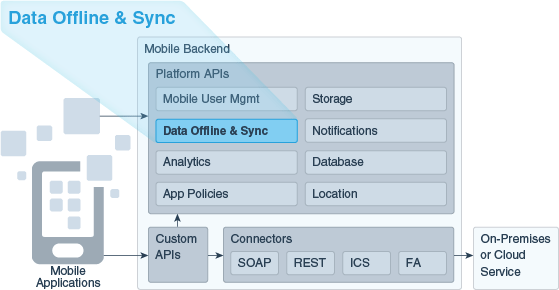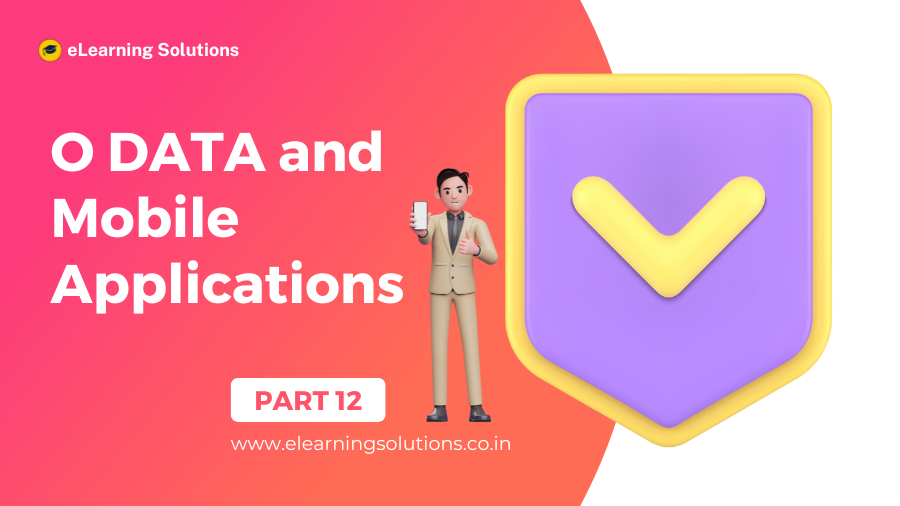In today’s digital age, mobile applications have become an integral part of our lives. They empower users to access information, perform tasks, and connect with others conveniently. As mobile apps rely heavily on data, integrating them with efficient data access mechanisms becomes crucial. O DATA, a standardized protocol, offers an excellent solution for seamless data integration in mobile applications. In this article, we will explore how O DATA enables the development of powerful and feature-rich mobile apps, its role in offline data synchronization, and the importance of mobile security in conjunction with O DATA.
The integration of O DATA in mobile applications opens up a world of possibilities for developers. By leveraging O DATA, mobile app developers can access and manipulate data from diverse sources using a single unified protocol. This eliminates the need to create custom APIs for different data sources, saving development time and effort.
Benefits of Using O DATA in Mobile Applications
-
-
- Seamless Data Access: O DATA simplifies data access, allowing mobile apps to retrieve data in a consistent and uniform manner from various backends, databases, and cloud services.
-
- Enhanced Querying: O DATA supports advanced query options, enabling developers to filter, sort, and paginate data efficiently, providing users with a smooth and interactive experience.
-
- Data Format Flexibility: O DATA supports various data formats like JSON and AtomPub, ensuring compatibility with different platforms and enabling efficient data serialization and deserialization.
O DATA for Offline Data Sync

One of the challenges mobile apps face is ensuring data availability when users are offline or have limited connectivity. O DATA offers robust offline data synchronization capabilities to address this challenge effectively.
With O DATA’s offline support, mobile apps can cache data locally on the device. Users can continue to interact with the app and make changes even when disconnected from the network. Once the device is back online, the app synchronizes the local data with the backend, ensuring data consistency.
Offline data sync with O DATA enhances user productivity and provides a seamless experience, even in low or intermittent network conditions. It is particularly valuable for apps that manage critical data, such as field service apps or inventory management systems.
Mobile Applications Security and O DATA

Mobile security is of paramount importance, especially when dealing with sensitive data. When integrating O DATA into mobile apps, it is crucial to implement robust security measures to protect data and ensure user privacy.
Authentication and Authorization:
O DATA supports various authentication mechanisms, such as OAuth, to authenticate users and ensure that only authorized users can access specific data. Implementing secure authentication protocols safeguards against unauthorized access and data breaches.
Securing O DATA Endpoints:
Securing O DATA endpoints with SSL/TLS encryption ensures that data transmitted between the mobile app and the backend is encrypted, preventing eavesdropping and man-in-the-middle attacks.
Data Encryption:
Storing sensitive data in encrypted formats on the device and backend further enhances data security. Mobile apps should employ industry-standard encryption algorithms to protect data at rest and in transit.
In conclusion, integrating O DATA in mobile applications offers numerous benefits, including streamlined data access, enhanced querying capabilities, and offline data synchronization. However, developers must prioritize mobile security by implementing robust authentication, endpoint encryption, and data encryption to safeguard sensitive information. By harnessing the power of O DATA, mobile apps can deliver a superior user experience and drive increased productivity and engagement.
FAQs
-
-
- Can O DATA be used with any mobile app development platform? Yes, O DATA is platform-agnostic and can be used with various mobile app development frameworks, including native app development (iOS and Android) and cross-platform frameworks like Xamarin and React Native.
-
- How does O DATA handle conflicts during offline data sync? O DATA provides conflict resolution mechanisms to handle data conflicts that may arise during offline data sync. Developers can implement custom conflict resolution logic or follow predefined resolution rules to ensure data consistency.
-
- Is O DATA suitable for real-time data-intensive mobile apps? O DATA is well-suited for real-time data-intensive mobile apps that require seamless data access and querying. However, performance optimization and caching strategies may be necessary for large-scale real-time applications.
-
- Can O DATA be used with mobile apps that have limited storage capacity? Yes, O DATA’s support for offline data sync allows mobile apps to cache only the necessary data, optimizing storage usage on devices with limited capacity.
Bonus: Enterprise Resource Planning(ERP) Unlocking Business Efficiency
PART-11
PART-13
Find Your Preferred Courses
SAP SD (Sales and Distribution) is a module in the SAP ERP (Enterprise Resource Planning) system that handles all aspects of sales and distribution processes. S4 HANA is the latest version of SAP’s ERP suite, built on the SAP HANA in-memory database platform. It provides real-time data processing capabilities, improved…
SAP Human Capital Management (SAP HCM) is an important module in SAP. It is also known as SAP Human Resource Management System (SAP HRMS) or SAP Human Resource (HR). SAP HR software allows you to automate record-keeping processes. It is an ideal framework for the HR department to take advantage…
I am text block. Click edit button to change this text. Lorem ipsum dolor sit amet, consectetur adipiscing elit. Ut elit tellus, luctus nec ullamcorper mattis, pulvinar dapibus leo.
Salesforce Developer Training Overview Salesforce Developer training advances your skills and knowledge in building custom applications on the Salesforce platform using the programming capabilities of Apex code and the Visualforce UI framework. It covers all the fundamentals of application development through real-time projects and utilizes cases to help you clear…
SAP EWM stands for Extended Warehouse Management. It is a best-of-breed WMS Warehouse Management System product offered by SAP. It was first released in 2007 as a part of SAP SCM meaning Supply Chain Management suite, but in subsequent releases, it was offered as a stand-alone product. The latest version…
Oracle PL-SQL is actually the number one database. The demand in market is growing equally with the value of the database. It has become necessary for the Oracle PL-SQL certification to get the right job. eLearning Solutions is one of the renowned institutes for Oracle PL-SQL in Pune. We believe…
Course details for Pega Training in Pune Elearning solution is the best PEGA training institute in Pune. PEGA is one of the Business Process Management tool (BPM), its development is based on Java and OOP concepts. The PAGA technology is mainly used to improve business purposes and cost reduction. PEGA…
SAP PP Training Institute in Pune SAP PP training (Production Planning) is one of the largest functional modules in SAP. This module mainly deals with the production process like capacity planning, Master production scheduling, Material requirement planning shop floor, etc. The PP module of SAP takes care of the Master…
SAP BASIS Module Course Content (1) Hardware and Software Introduction (i) Hardware (a) Hardware Introduction (b) Architecture of different Hardware devices (ii) Software (a) Software Introduction (b) Languages and Software Development (c) Introduction to OS (d) Types of OS (iii) Database Concepts (a) Introduction (b) Database Architecture and concepts (c)…
Curriculum Details SAP HANA Administration SAP HANA Introduction SAP HANA Introduction SAP HANA Information Sources Installation Preparation SAP HANA Sizing Linux Operating system requirements SAP HANA Installation Introduction to SAP HANA Lifecycle Management tools Describing Advanced Installation options Explaining a Distributed system SAP HANA Architecture SAP HANA Architecture and Technology…
Business Warehouse (BW) is SAP’s data warehousing application; it uses an SAP NetWeaver application server, but can run on many different databases. Improvements come with each version of Courses for sap BW on HANA training, but a really big jump in functionality comes when SAP BW is installed on the…
SAP SAP HANA simple logistics is also known as HANA enterprise management. Different area of business is combined in this suit itself like HANA enterprise-management helps in faster and efficient processing of business data in the area of logistics, supply chain, procurement, user experience, sales, partner management. So Course for…
ABAP remains a key language as many SAP business applications and custom developments are written in ABAP, with Courses for sap ABAP on HANA training there are numerous improvements. The ABAP language, which allows writing streamlined ABAP code and benefit from SAP HANA. SAP HANA is a relational DBMS in SAP…
SAP HANA is the latest ERP Solution from SAP, which is a combination of Hardware and Software. HANA has unprecedented adoption by the SAP customers. courses for SAP HANA training institutes. SAP HANA is the latest, in-memory database, and platform which can be deployed on-premises or cloud. SAP HANA is a…
Oracle Applications R12 HRMS is one of the most demanded applications by most organizations. It is the core application possess by the ERP system. The core objective of the organization to implement Oracle R12 HRMS is to organize the entire activates of human resources management. An Elearning solution is well…
Elearning solutions provide training suit for Oracle Apps R12 SCM with training from industry experts. The organizations are adopting Oracle’s supply chain management cloud as they deliver the insights, visibility, and capabilities for organizations’ management. Oracle Apps R12 SCM allows the industry to create own intelligent supply chain. Hence, it…
Oracle Apps R12 Technical Course Elearning solutions is the best Oracle Apps R12 technical course in Pune owned by well trained and certified trainers. The training is conducted by the best experienced IT professionals with skilled resources. The course structure is based on the real-time scenario so that it will…

₹25,000.00
Elearning solutions is the best SAP FICO training institute in Pune. SAP FICO is the Finance and Cost controlling module is one of the most important and widely used SAP ERP modules among organizations. As it is very robust and encounter almost all the business processes. In SAP FICO, FI…
Elearning solutions provide SAP SD training. The tutorials are designed for the students who desired to understand SAP SD concepts and implement them in practice. The SAP SD training is delivered by industry experts, who are aware of the real-time scenarios. Hence, supporting students understand, what will be there on…
SAP WM training is offered by Elearning solutions provides 100% hands-on practical classes. The primary focus of training is getting placement for all the students. The tutorials are designed for the students who wished to work on live projects for the organizations. The syllabus of SAP WM training is crafted…
Elearning solutions are the best SAP MM training institute in Pune. SAP MM (material management system) is one of the important models of the SAP ERP system, which is particularly designed for business processes. SAP MM deals with the entire material and inventory management of the organization. The module is…
Elearning Solutions best SAP ABAP training institute in Pune provides real-time training for students. SAP ABAP (Advanced Business Application Programming) is a programming language for building SAP applications such as SAP R/3 which runs in the SAP ABAP runtime environment. (SAP ABAP online course) SAP ABAP is used by organizations…






 WhatsApp us
WhatsApp us